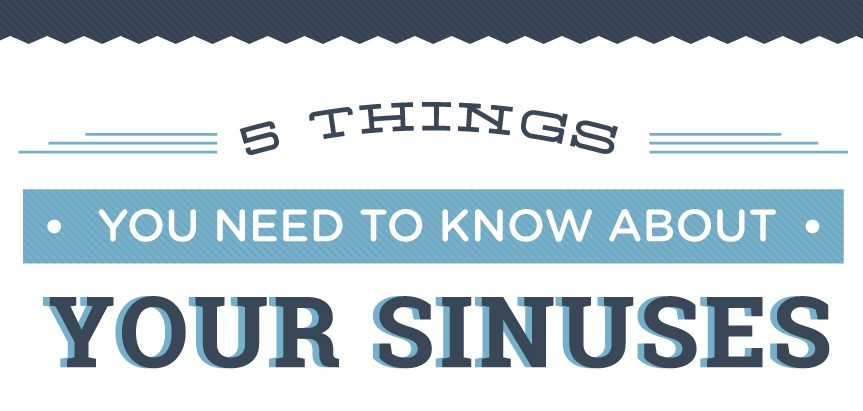Infographic created by Dr. Monica Tadros, M.D., F.A.C.S. visualizes 5 things you need to know about your sinuses. Sinus disease has become more common over the years because of a number of contributing factors. Underlying allergies, smoking, untreated nasal fractures, environmental irritants and antibiotic resistance are among the most common to blame.
What is sinuses?
Sinuses is caused by infections that enduse inflammation in the sinuses. Microorganisms in the form of viruses, bacteria or fungus may grow within a sinus and develop inflammation and blockage of the opening where the sinus is suppose to drain. This results in pressure and retained fluid in the sinuses called an acute sinus infection.
Symptoms of sinuses?
Symptoms may include sinus headache, facial pain, nasal drainage, nasal stuffiness and facial pressure. Occasionally this may be accompanied by fever, sore throat or cough. When the eyes fail to drain into the nose, excessive tearing may occur. When the middle ears fail to drain into the nose, ear pressure and pain can occur.
5 Things You Need to Know About Your Sinuses
Frontal sinuses are located in the forehead and can cause frontal headaches and pressure.
Maxillary sinuses are located in the cheek area and can cause facial pain that may radiate to the teeth.
Sphenoid sinuses are located in the center of the skull and can cause pain radiating to the top and back of the head.
Ethmoid sinuses are located between the eyes and can cause pain that radiates to the eye area.
The sinuses, eyes, and ears all drain into the nose. Symptoms of sinus disorders vary widely.
Here are some tips addressing common issues that affect your sinuses.
-
Keep Kleenex handy
Clearing secretions by gently blowing your nose rather than inhaling alleviates sinus blockage and pressure.
-
Use an expectorant
An expectorant like Mucinex (Guaifenesin) is a medication used to thin out your nasal secretions. This can be used in conjunction with a decongestant that will reduce swelling and sinus pressure.
Home Remedies
Include: High dose vitamin C, a personal steam vaporizer, and saline rinses to moisturize and cleanse the sinuses.
Vicks can be placed on the upper lip skin just under the nose (never within the nostrils) to stimulate circulation.
Try keeping your head elevated on pillows while sleeping. This can also help decrease swelling and congestion. -
The common cold is usually a virus
A virus after 4 to 5 days tends to block the sinuses and may trigger a bacterial sinus infection. Unlike the common cold virus, bacterial sinus infections are generally not contagious.
-
Signs and symptoms of sinusitis
– Headaches, pressure or pain in the sinus area
– Nasal stuffiness
– Facial swelling
– Yellow or greenish Marcus
– Sore throat and coughing from a backdrip
– Fever
Acute sinusitis usually feels like a prolonged cold. Chronic sinusitis may be more difficult to diagnose. Prolonged symptoms of headache, facial pain or sinus pressure that failed to resolve after antibiotics may indicate a chronic condition. -
See a specialist for treatment options
If you had two or more sinus infections suffer from sinus pressure or headaches, it is best to seek out a specialist for an evaluation.
An ear nose and throat specialist (Otolaryngologist) can help guide you with treatment options and prevention.
Learn more about Sinus and Allergy.



